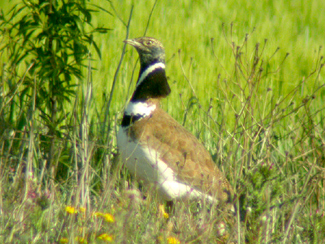Adverse Effects of Capturing and Handling Little Bustard

The little bustard (Tetrax tetrax) is a globally near-threatened species distributed from Central Asia, where population trends are unknown, to Western Europe, where populations have declined rapidly as a consequence of agricultural intensification and habitat transformation. Capture and radiotagging of little bustards is necessary to obtain ecological and demographic data needed to implement conservation practices in an increasingly fragmented habitat. Capturing and handling any wild animals may cause some adverse effects, which is only acceptable if these are outweighed by conservation benefits.
We used information from 3 on-going telemetry studies on the endangered little bustard in Western Europe to evaluate the risk factors associated with capture and handling. Of 151 telemetered little bustard, 23 (15.2%) exhibited impaired mobility and coordination after release, probably related to the occurrence of capture myopathy. Among the 23 impaired birds, 10 (43.5%) died before recovering normal mobility (6.6% of all birds captured).
Logistic regression analyses identified longer handling time, longer restraint time, use of cannon nets, and capture of juveniles as inducing factors for these disorders. Our results highlight the importance of reducing the total time of handling and restraint to minimize the risk of occurrence of adverse effects when capturing and handling sensitive species such as the little bustard. Staff awareness and teaming during capture and handling are crucial to achieving this goal. Small nets that allow only individual captures and adequate mesh size that reduces entanglements also may help to reduce restraint time. In the case of the little bustard, we recommend not to exceed 20 minutes of total time of handling and restraint, to keep the risk of occurrence of mobility alterations to a minimum. Caution must be extreme when capturing juvenile birds or when using cannon nets. Under these circumstances, we recommend to keep the total time of handling and restraint below 10 minutes.
Ignasi Marco
Servei d'Ecopatologia de Fauna Salvatge
References
"Adverse effects of capture and handling little bustard", Ponjoan, Anna; Bota, Gerard; De La Morena, Eladio L. Garcia; Morales, Manuel B.; Wolff, Axel; Marco, Ignasi; Manosa, Santi. JOURNAL OF WILDLIFE MANAGEMENT, 72 (1): 315-319 JAN 2008


